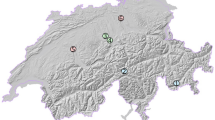Abstract
Based on previous investigations, adult Australian plague locusts are believed to migrate on warm nights (with evening temperatures >25 °C), provided daytime flight is suppressed by surface winds greater than the locusts’ flight speed, which has been shown to be 3.1 m s−1. Moreover, adult locusts are believed to undertake briefer ‘dispersal’ flights on nights with evening temperature >20 °C. To reassess the utility of these conditions for forecasting locust flight, contingency tests were conducted comparing the nights selected on these bases (predicted nights) for the months of November, January, and March and the nights when locust migration were detected with an insect monitoring radar (actual nights) over a 7-year period. In addition, the wind direction distributions and mean wind directions on all predicted nights and actual nights were compared. Observations at around 395 m above ground level (AGL), the height at which radar observations have shown that the greatest number of locusts fly, were used to determine the actual nights. Tests and comparisons were also made for a second height, 990 m AGL, as this was used in the previous investigation. Our analysis shows that the proposed criteria are successful from predicting migratory flight only in March, when the surface temperature is effective as a predicting factor. Surface wind speed has no predicting power. It is suggested that a strong daytime surface wind speed requirement should not be considered and other meteorological variables need to be added to the requirement of a warm surface temperature around dusk for the predictions to have much utility.





Similar content being viewed by others
References
Batschelet E (1981) Circular statistics in biology. Academic Press, London
Clark DP (1969) Night flights of the Australian plague locust, Chortoicetes terminifera Walk., in relation to storms. Aust J Zool 17(2):329–352
Deveson ED, Drake VA, Hunter DM, Walker PW, Wang HK (2005) Evidence from traditional and new technologies for northward migrations of Australian plague locusts (Chortoicetes terminifera) (Walker) (Orthoptera: Acrididae) to western Queensland. Austral Ecol 30(8):928–943
Drake VA (2002) Automatically operating radars for monitoring insect pest migrations. Insect Science 9(4):27–39
Drake VA, Farrow RA (1983) The nocturnal migration of the Australian plague locust, Chortoicetes terminifera (Walker) (Orthoptera, Acrididae): quantitative radar observations of a series of northward flights. B Entomol Res 73(4):567–585
Drake VA, Wang HK (2013) Recognition and characterization of migratory movements of Australian plague locusts, Chortoicetes terminifera, with an insect monitoring radar. J Appl Remote Sens 7(1):1–17. doi:10.1117/1.Jrs.7.075095
Fisher NI (1995) Statistical analysis of circular data. Cambridge University Press, Cambridge
Hao ZH (2016) Testing ideas about Australian insect migration using entomological radar observations and a regional scale meteorological model. University of New South Wales, Canberra
Hu G, Lim KS, Reynolds D, Reynolds A, Chapman J (2016) Wind-related orientation patterns in diurnal, crepuscular and nocturnal high-altitude insect migrants. Front Behav Neurosci 10:32
Hunter DM (1981) Annual report research supplement. Department of Primary Industy, Australian Plague Locust Commission, Australia
Hunter DM (1983) The maintenance of body temperature in adult Australian plague locusts. Austral Entomol 22(2):135–136
Hunter DM, Mcculloch L, Wright DE (1981) Lipid-accumulation and migratory flight in the Australian plague locust, Chortoicetes-Terminifera (Walker) (Orthoptera, Acrididae). Bull Entomol Res 71(4):543–546
Hurley P (2008) TAPM V4. Part 1: technical description. CSIRO marine and atmospheric research, Australia
Hurley P, Edwards M, Luhar AK (2008) TAPM V4. Part 2: summary of some verification studies. CSIRO marine and atmospheric research paper, Australia
Love G, Riwoe D (2005) Economic costs and benefits of locust control in eastern Australia. Australian Bureau of Agricultural and Resource Economics, Australia
Sokal RR, Rohlf FJ (1995) Biometry: the principles and practice of statistics in biological research. WH Freeman and Company, New York
Symmons PM (1986) Locust displacing winds in eastern Australia. Int J Biometeorol 30(1):53–64. doi:10.1007/Bf02192059
Taylor JR, Zawar-Reza P, Low DJ, Aryal P (2005) Verification of a mesoscale model using boundary layer wind profiler data. In: Australian Institute of Physics 16th Biennial Congress,
Wang HK (2008) Evaluation of insect monitoring radar technology for monitoring locust migrations in inland Eastern Australia. Thesis. The University of New South Wales, Canberra
Acknowledgments
Haikou Wang, Shane Hatty, and the Australian Plague Locust Commission assisted with the operation and maintenance of the entomological radar during 2006–2008. The first author is grateful for the financial support from China Scholarship Council and UNSW Canberra. The paper has been greatly improved thanks to comments from two anonymous reviewers.
Author information
Authors and Affiliations
Corresponding author
Electronic supplementary material
ESM 1
(DOCX 96 kb)
Rights and permissions
About this article
Cite this article
Hao, Z., Drake, V.A., Sidhu, L. et al. Locust displacing winds in eastern Australia reassessed with observations from an insect monitoring radar. Int J Biometeorol 61, 2073–2084 (2017). https://doi.org/10.1007/s00484-017-1404-3
Received:
Revised:
Accepted:
Published:
Issue Date:
DOI: https://doi.org/10.1007/s00484-017-1404-3




